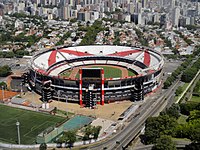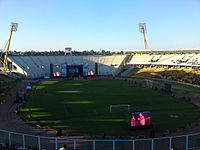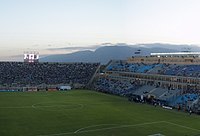Loading AI tools
International football competition From Wikipedia, the free encyclopedia
The 2011 Campeonato Sudamericano Copa América, better known as the 2011 Copa América or the Copa América 2011 Argentina, was the 43rd edition of the Copa América, the main international football tournament for national teams in South America. The competition was organized by CONMEBOL, South America's football governing body, and was held in Argentina from 1 to 24 July. The draw for the tournament was held in La Plata on 11 November 2010.
| Copa América Argentina 2011 | |
|---|---|
 | |
| Tournament details | |
| Host country | Argentina |
| Dates | 1–24 July |
| Teams | 12 (from 2 confederations) |
| Venue(s) | 8 (in 8 host cities) |
| Final positions | |
| Champions | |
| Runners-up | |
| Third place | |
| Fourth place | |
| Tournament statistics | |
| Matches played | 26 |
| Goals scored | 54 (2.08 per match) |
| Attendance | 882,621 (33,947 per match) |
| Top scorer(s) | (5 goals) |
| Best player(s) | |
| Best young player | |
| Best goalkeeper | |
| Fair play award | |
← 2007 2015 → | |
Uruguay won the tournament after defeating Paraguay 3–0 in the final, giving them a record 15th Copa América title and their first since 1995. Paraguay, as the tournament runner-up, earned the Copa Bolivia; Paraguay's performance was noteworthy, as they were able to reach the finals without winning a single game in the tournament; their success in the final stages was achieved by the way of penalty shoot-outs. Brazil were the defending champions but were eliminated by Paraguay in the quarter-finals after failing to convert any of the penalties.[1][2] As the tournament champion, Uruguay earned the right to represent CONMEBOL in the 2013 FIFA Confederations Cup, held in Brazil. Despite losing to Peru 4–1 in the third-place match, Venezuela had their best ever performance in the tournament.

Both Japan and Mexico were invited to join the CONMEBOL nations in the tournament.[3] Following a proposal by UEFA regarding national teams competing in tournaments organised by confederations different from their own, it was reported on 23 November 2009 that the two countries might not be able to take part in the 2011 Copa América.[4] However, on 31 March 2010, CONCACAF confirmed that Mexico would be allowed to send their 2012 U-23 Olympic Team, supplemented with five over-age players.[5] In addition to Mexico sending a weaker team than those teams sent in previous participations, eight of the Mexican players originally called to play the Copa America 2011 were suspended because of indiscipline one week before the competition started.
Japan's participation was in doubt after the 2011 Tōhoku earthquake and tsunami,[6] but the Japan Football Association confirmed on 16 March 2011 that they would participate.[7] However, the Japanese FA later withdrew from the tournament on 4 April 2011 citing scheduling conflict with rescheduled J. League matches.[8][9] Following a meeting with the leadership of the Argentine Football Association, the Japanese FA decided to hold off on their final decision until 15 April.[10][11] The Japanese FA later announced on 14 April that they would compete in the competition using mainly European based players.[12] The Japanese FA withdrew their team again on 16 May citing difficulties with European clubs in releasing Japanese players.[13][14] On the next day, CONMEBOL sent a formal invitation letter to the Costa Rican Football Federation inviting Costa Rica as replacement.[15] Costa Rica accepted the invitation later that day.[16][17]
The following twelve teams, shown with pre-tournament FIFA World Rankings, played in the tournament:
A total of eight cities hosted the tournament. The opening game was played at Estadio Ciudad de La Plata, and the final was played at Estadio Monumental Antonio Vespucio Liberti.[18]
| Buenos Aires | Córdoba | La Plata | Santa Fe |
|---|---|---|---|
| Estadio Monumental | Estadio Mario Alberto Kempes | Estadio Ciudad de La Plata | Estadio Brigadier General Estanislao López |
| Capacity: 65,921 | Capacity: 57,000 | Capacity: 53,000 | Capacity: 47,000 |
 |
 |
 |
 |
| Mendoza | San Juan | ||
| Estadio Malvinas Argentinas | Estadio del Bicentenario | ||
| Capacity: 40,268 | Capacity: 25,000 | ||
 |
 | ||
| Jujuy | Salta | ||
| Estadio 23 de Agosto | Estadio Padre Ernesto Martearena | ||
| Capacity: 23,000 | Capacity: 20,408 | ||
 |
 | ||
The draw for the competition took place on 11 November 2010 at 17:00 (UTC−03:00) in the Teatro Argentino de La Plata in La Plata, and was broadcast in Argentina by Canal Siete.[19][20][21] On 18 October 2010, CONMEBOL's The executive committee decided to place the teams in pots for the draw.[22]
Each association presented a list of twenty-three players to compete in the tournament five days before their first match. On 14 June 2011, CONMEBOL allowed for the inscription of twenty-three players for the tournament, up one player from the previous allowed twenty-two. Of those twenty-three players, three must be goalkeepers.[23]
The list of twenty-four referees and two extra referees selected for the tournament were announced on 6 June 2011 by CONMEBOL's Referee Commission. Two referees were chosen from each participating association:[24][25]
|
|
|
Extra assistants: ![]() Diego Bonfa, Hernán Maidana
Diego Bonfa, Hernán Maidana
The first round, or group stage, saw the twelve teams divided into three groups of four teams.[27] Each group was a round-robin of three games, where each team played one match against each of the other teams in the same group. Teams were awarded three points for a win, one point for a draw and none for a defeat. The teams finishing first and second in each group, and the two best-placed third teams, qualified for the quarter-finals.[28]
Teams were ranked on the following criteria:[29]
| Key to colors in group tables | |
|---|---|
Teams that advanced to the quarter-finals
| |
All times are in local, Argentina Time (UTC−03:00).
| Team | Pld | W | D | L | GF | GA | GD | Pts |
|---|---|---|---|---|---|---|---|---|
| 3 | 2 | 1 | 0 | 3 | 0 | +3 | 7 | |
| 3 | 1 | 2 | 0 | 4 | 1 | +3 | 5 | |
| 3 | 1 | 0 | 2 | 2 | 4 | −2 | 3 | |
| 3 | 0 | 1 | 2 | 1 | 5 | −4 | 1 |
| 1 July 2011 | |||
| Argentina | 1–1 | Estadio Ciudad de La Plata, La Plata | |
| 2 July 2011 | |||
| Colombia | 1–0 | Estadio 23 de Agosto, Jujuy | |
| 6 July 2011 | |||
| Argentina | 0–0 | Estadio Brigadier General Estanislao López, Santa Fe | |
| 7 July 2011 | |||
| Bolivia | 0–2 | Estadio 23 de Agosto, Jujuy | |
| 10 July 2011 | |||
| Colombia | 2–0 | Estadio Brigadier General Estanislao López, Santa Fe | |
| 11 July 2011 | |||
| Argentina | 3–0 | Estadio Mario Alberto Kempes, Córdoba |
At the end of the first stage, a comparison was made between the third-placed teams of each group. The two best third-placed teams advanced to the quarter-finals.
Different from previous tournaments, in the knockout stage, 30 minutes of extra time were played if any match finished tied after regulation (previously the match would go straight to a penalty shoot-out).[30] This was the first time in the history of the tournament where the knockout stage did not include any invited teams, as both Mexico and Costa Rica were eliminated during the group stage. Paraguay reached the final despite not having won a single match in the competition.
| Quarter-finals | Semi-finals | Final | ||||||||
| July 16 - Córdoba | ||||||||||
| 0 | ||||||||||
| July 19 - La Plata | ||||||||||
| 2 | ||||||||||
| 0 | ||||||||||
| July 16 - Santa Fe | ||||||||||
| 2 | ||||||||||
| 1 (4) | ||||||||||
| July 24 - Buenos Aires | ||||||||||
| 1 (5) | ||||||||||
| 3 | ||||||||||
| July 17 - La Plata | ||||||||||
| 0 | ||||||||||
| 0 (0) | ||||||||||
| July 20 - Mendoza | ||||||||||
| 0 (2) | ||||||||||
| 0 (5) | ||||||||||
| July 17 - San Juan | ||||||||||
| 0 (3) | Third place play-off | |||||||||
| 1 | ||||||||||
| July 23 - La Plata | ||||||||||
| 2 | ||||||||||
| 4 | ||||||||||
| 1 | ||||||||||
| 2011 Copa América champions |
|---|
Uruguay 15th title |

With five goals, Paolo Guerrero of Peru was the top scorer in the tournament. There were 54 goals scored in 26 matches, for an average of 2.08 goals per match.
5 goals
4 goals
3 goals
2 goals
1 goal
1 own goal
| 2011 Copa América champions |
|---|
Uruguay |


| Goalkeeper | Defenders | Midfielders | Forwards | Manager |
|---|---|---|---|---|
|
|
Global Platinum Sponsor:
Global Gold Sponsor:
Global Silver Sponsor:
Official Supplier:
Charitable Partner:
Local Supplier:
Web Hosting:
"Creo en América" (English: I Believe in America) by Argentine singer Diego Torres was the official theme song for the tournament.[45] Torres performed the song during the opening ceremonies. A secondary theme song for the tournament is "Ready 2 Go" by Martin Solveig featuring Kele.[46]
Seamless Wikipedia browsing. On steroids.
Every time you click a link to Wikipedia, Wiktionary or Wikiquote in your browser's search results, it will show the modern Wikiwand interface.
Wikiwand extension is a five stars, simple, with minimum permission required to keep your browsing private, safe and transparent.